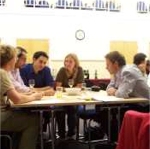I met up with Barry a few weeks back. Barry works for a large global food manufacturer. I did a lot of work for him a couple of years ago at their corporate HQ. A buzz of excitement came back as I remembered the work we did together.
Barry and I worked in an unusual but highly successful way. He was trying to get Notes more widely accepted and used in the organisation but did not have a lot of money or support. Solution: He bought several days of my time. He identified several potential Notes applications - simple but effective ones. I came in and then sat down with the person who would own the database - no spec - no pre-discussion - they would explain to me what they wanted - we might have to show them Notes first - and I'd build the application then and there with them on the fly!!
We would never spend more than a couple of hours initially on the application - but they would go away with a prototype application that they could start to use/enter data in - think about as appropriate. If it looked promising we would spend more time at other so called "Notes Surgery" until we had a fully working application. For some people - we would teach them some basic Notes development skills and let them complete or add to the application - even one or two secretarial/admin level staff. We probably never spent more than 3 days on any one application.
Not all applications can be developed like this or in this sort of time frame but Barry chose ones that could. He wanted high pay back, user buy-in and excitement and to help spread the use of Notes more widely. As I discovered last week - it was very successful - he now has over 3,500 users and approaching 1,000 applications. Interestingly he has pushed the ownership and maintenance of the applications on to the users and has a central catalogue database (which I developed) to manage them all and allow new users to identify which apps are relevant to them!
We developed something like 20 applications in 4 months elapsed time for about 25 days of my time!
Well Barry and I did it again and I have just completed 4 days work to put together a workflow application for him. He wanted it quickly and inexpensively. I only had 4 days so that was the budget! As Barry and I knew and trusted each other - we worked to our old URAD methodology. On site, together, intensive!
We designed the application the first morning - at least half of that time taken up with infrastructure issues as they planned to zap megabyte artwork files around their network. Myself, Barry (IT type) and Tim (owner to be of application) and briefly his boss Helen. No documentation, no spec, back of an envelope and lots of trust. At the end of the first day the application although far from complete was demonstrable. I could prove to Barry and Tim that the concept was feasible and that they would be happy with the outcome.
I completed the application on the lunch time of the fourth day, fully tested, documented, loaded on servers, access control, ACL groups and roles all set up. Lots of collaboration. iteration with Barry, Tim and Helen. Just to make life difficult- over the 4 days, Barry was off-site after the first day and Tim's department was moving buildings. At times I was moved from PC to PC.
The application although simple is in fact a very powerful little workflow application for approving the artwork of packaging. Acrobat file of artwork passed from origination's to technical, to QA to Marketing for sign-off approval. Need for application brought on by QA's move to another site and need to avoid cost of courier and slow turnaround.
I reckon, if I had developed this application in the traditional manner - it would have taken me twice as long say 8 days. Also note - it requires a very high degree of trust which Barry and I had build up during a previous project. If a project like this went wrong with a client whom I did not have a trust relationship I would be in deep do-dah.


